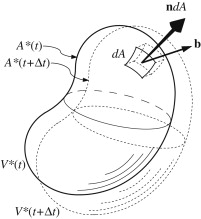The geometry for the two integrals inside the \(\{\}\)-braces is shown where solid lines represent time \( t \) and dashed lines represent time \( t + \Delta t \). The time derivative of the integral on the left is properly written as a total time derivative since the volume integration subsumes the possible spatial dependence of \( F \).

Geometrical depiction of a control volume \( V^*(t) \) having a surface \( A^*(t) \) that moves at a nonuniform velocity \( \mathbf{b} \) during a small time increment \( \Delta t \).
When \( \Delta t \) is small enough, the volume increment \( \Delta V = V^*(t+\Delta t) - V^*(t) \) will lie very near \( A^*(t) \), so the volume-increment element adjacent to \( dA \) will be \( (\mathbf{b} \Delta t) \cdot \mathbf{n} dA \) where \( \mathbf{n} \) is the outward normal on \( A^*(t) \).